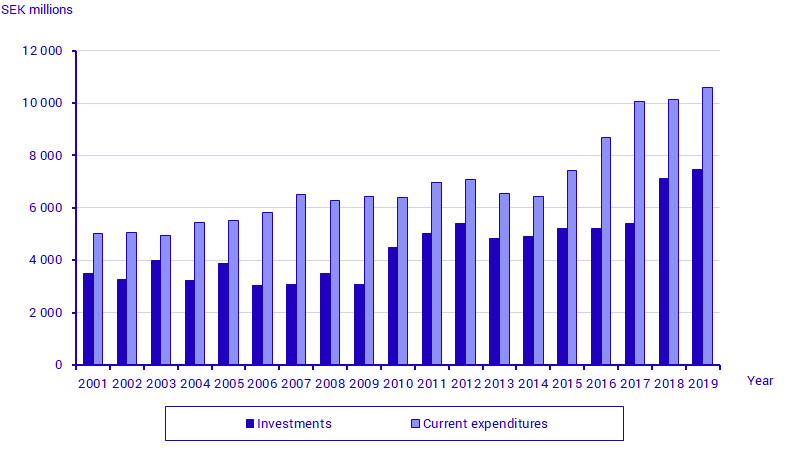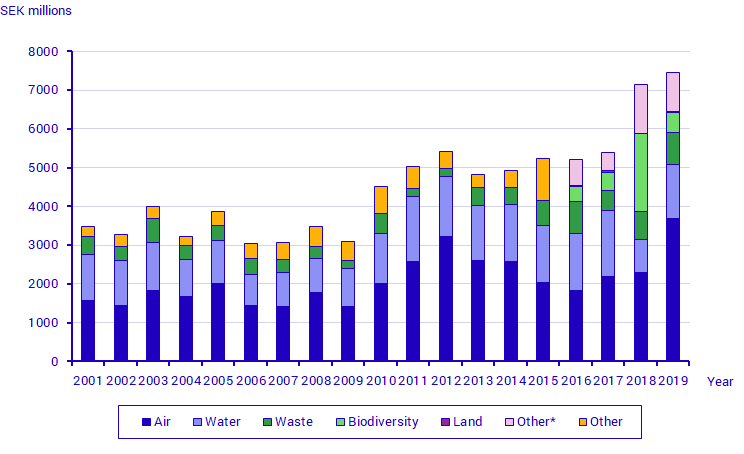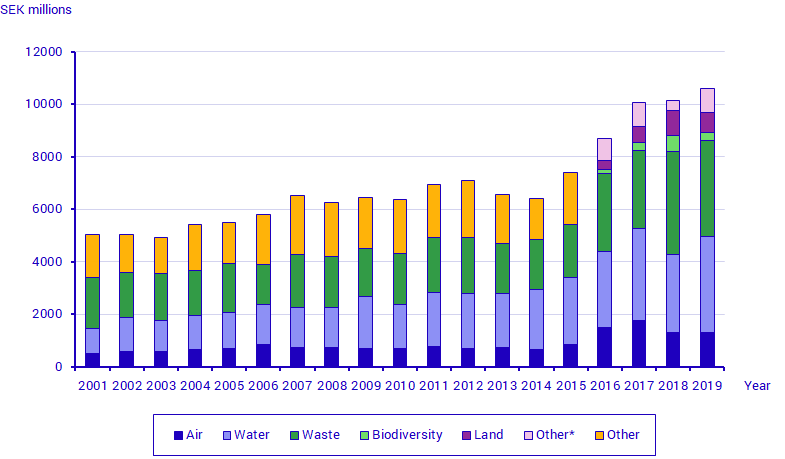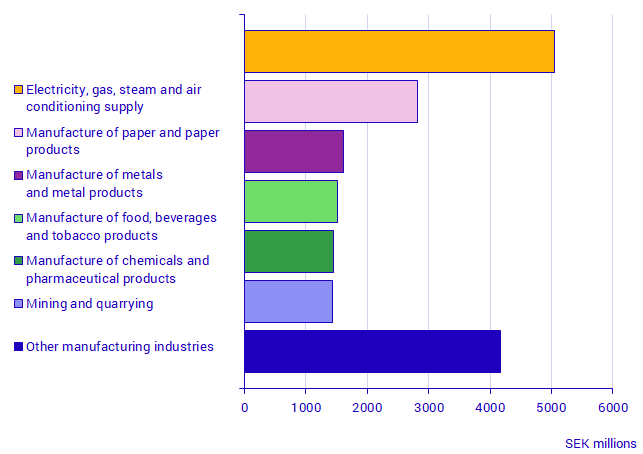Environmental protection expenditure 2019
Current environmental protection expenditure increased in 2019
Statistical news from Statistics Sweden 2020-10-14 9.30
Swedish industry’s total environmental protection expenditure amounted to SEK 18.1 billion in 2019, which is 4 percent more than in 2018. This increase is due to rising current environmental protection expenditure.
In 2019, the largest total expenditure on environmental protection, SEK 5 billion, was noted in the electricity, gas and heating industry. This corresponds to 28 percent of total environmental protection expenditure. The second largest contribution came from the manufacture of paper and paper products industry, which accounted for 16 percent of total environmental protection expenditure.
Environmental protection investments accounted for 41 percent of total environmental protection expenditure, while current expenditures (such as maintenance, management, and fees) accounted for 59 percent. In 2019, current expenditures amounted to SEK 10.6 billion, while investments amounted to SEK 7.5 billion. Current expenditures on environmental protection were 4.5 percent higher than in 2018, and have increased steadily over the years. Environmental protection investments were 6 percent higher than in 2018.

Investments in protection of ambient air and climate increased
In 2019, the largest environmental protection investments focused on the protection of ambient air and climate. Investments in this domain accounted for 50 percent of total investments in environmental protection in 2019. Investments included the installation of treatment plants, updates of production facilities, and the installation of new filters.
Investments to minimise effects on biodiversity and landscapes accounted for 13 percent of total investments in 2019. This proportion is smaller than in 2018, but larger than in 2016 and in 2017. Investments in wastewater management accounted for 19 percent of total investments, and increased from SEK 800 million in 2018 to SEK 1.4 billion in 2019.

* The biodiversity, land, and “other” domains were previously included in the “other” domain. From 2016 onwards, this domain has been divided into three separate domains.
Current environmental expenditures focused on waste management and wastewater management
The largest current environmental expenditures in 2019 referred to wastewater management and waste management. Expenditures for wastewater management and waste management accounted for 34 percent each of total current environmental expenditures in 2019. Wastewater management increased by 23 percent compared with 2018, whereas waste management decreased by 7 percent in a corresponding comparison. Current expenditures on wastewater management include the operation and maintenance of treatment plants, such as electricity, chemicals, and sampling. Waste management includes waste management of environmentally hazardous waste, expenditures on transport to landfills, and operation and maintenance of waste facilities.

*The biodiversity, land and “other” domains were previously included in the “other” domain. From 2016 onwards, this domain has been divided into three separate domains.
Total environmental protection expenditure by NACE industry
In 2019, the electricity, gas and heating industry (NACE 35) and the manufacture of paper and paper products industry (NACE 17) were the industries that noted the largest total environmental protection expenditure.
In the electricity, gas and heating industry, total expenditures amounted to SEK 5 billion. Investments were mainly focused on the protection of air, while current environmental expenditures often focus on waste management. Expenditures include items such as the reconstruction of production facilities, the expansion of district heating networks, flue gas treatment, waste management (ash), and protection against radiation.
In the manufacture of paper and paper products industry, total expenditures amounted to SEK 2.9 billion. Both investments and current environmental expenditures focus on wastewater management. Expenditures include items such as the operation and maintenance of treatment plants and sewage treatment plants, and other types of various investments to improve sewage treatment plants.
Other industries with considerable environmental protection expenditure, mainly in wastewater management and waste management, include the manufacture of metal and metal products industries (NACE 24-25), the manufacture of food, beverages and tobacco industries (NACE 10-12), and the manufacture of chemicals and pharmaceuticals industries (NACE 20-21).

Definitions and explanations
Environmental protection refers to activities that aim to prevent, reduce or eliminate pollution or other deterioration of the environment. Eurostat, the statistical office of the European Union, has produced common international definitions for environmental protection and how expenditures are to be calculated.
Investments in environmental protection are broken down into investments for emissions treatment that do not affect the process (such as filters and separate purification plants), and investments for the prevention of emissions involving investments in new or changed production processes. Current expenditure consists of expenditure for staff, energy, materials, and supplies, such as for the operation and supervision of purification plants, for environmental administration tasks, environmental management and certification, as well as waste management. Payments to others who carry out these measures are also included.
Next publishing will be
Environmental protection expenditure 2020 will be published in October 2021.
Feel free to use the facts from this statistical news but remember to state Source: Statistics Sweden.
